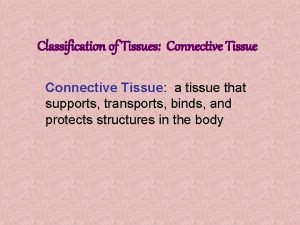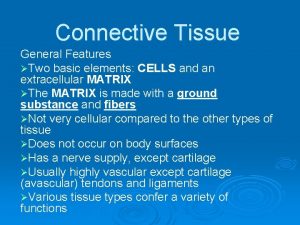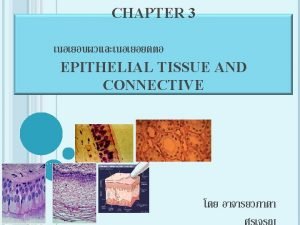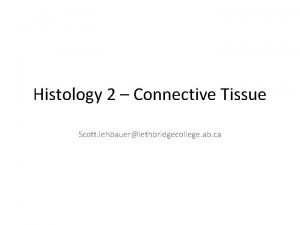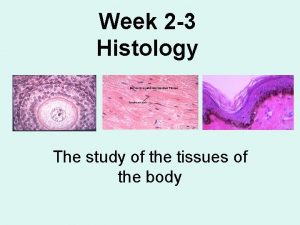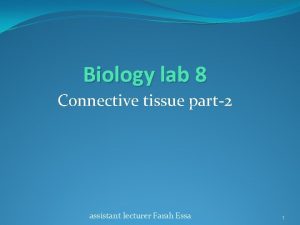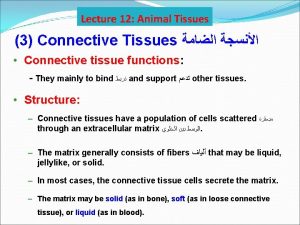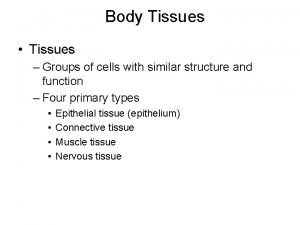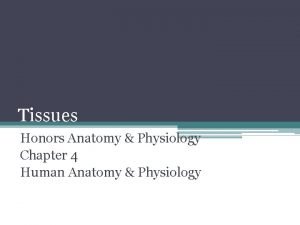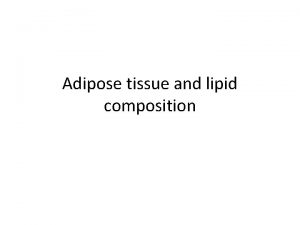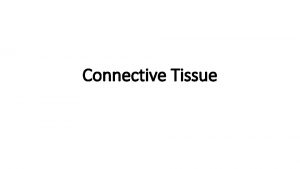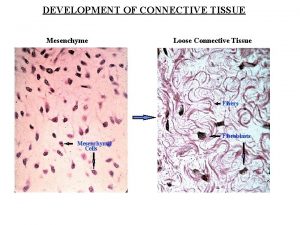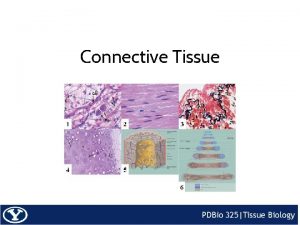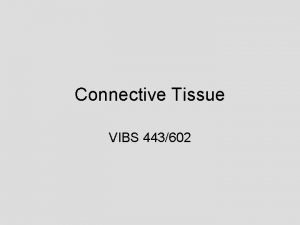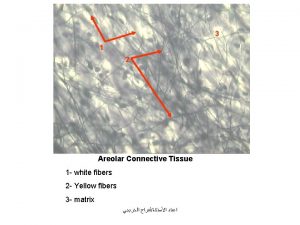Connective tissue 1 Loose Connective Tissue Areolar Adipose












- Slides: 12

Connective tissue 1. ) Loose Connective Tissue -Areolar -Adipose -Reticular 2. ) Dense Connective Tissue -Dense Regular -Dense Irregular -Elastic 3. ) Cartilage -Hyaline -Elastic -Fibrocartilage 4. ) Bone -osseous tissue 5. ) Blood

Areolar Tissue • Type of loose connective tissue • Wraps and cushions organs • Is found just under epithelial tissue • Packages capillaries and blood vessels • You receive shots in this tissue

Adipose Tissue • Observed as a large bubble-like cell lumped together. • Cells are filled with fat (adipocytes) • Stored energy for the body. • Helps cushion areas like the eyes, kidneys, abdomen, and breasts. • Also insulates the body and organs

Adipose Tissue Figure 4– 10 a

Types of Adipose Tissue • White fat: o most common o stores fat o absorbs shocks o slows heat loss (insulation) • Brown fat: very little in adults -more vascularized -adipocytes have many mitochondria -breaks down fat -produces heat

Reticular Tissue • Large dark fibers that help support the cells of certain organs- spleen, liver, lymph nodes and bone marrow. • Fibers help support other cells within the tissue like o White blood cells o Mast cells o macrophages

Reticular Tissue Figure 4– 10 b

Dense Regular Tissue • This is the tissue of tendons and ligaments. Holding bones to bones or muscles to bones. • Withstands tension as force is applied in one direction. • Mainly called collagen fibers. (Parallel fibers) • Embedded in the fibers are fiber producing cells called Fibroblasts.

Dense Irregular Tissue • Tissue within the Dermis of skin, Submucosa of the digestive tract and Fibrous Capsules of organs and joints. • Able to withstand force exerted in many different directions, while providing structural support. • Instead of being organized neatly as parallel fibers, fibers seem more unorganized within the tissue.

Cartilage Types • Hyaline Cartilageo Chondrocyte Cells form an amorphous matrix (no form) that is compact with fibers of collagen. o The cells sit in tiny chambers called Lacunae. o Has very resilient cushioning properties that support and reinforce during compressive force. o Found on the ends of long bones within a joint, form the costal cartilage of the ribs, as well as the cartilage of the nose, trachea and larynx.

Elastic cartilage • Similar to hyaline cartilage but with more elastic fibers within. • Maintains shape and structure while allowing great flexibility. • Found on the outer ear (pinna) and epiglottis.

Fibrocartilage • Less firm than that of hyaline cartilage. • Thick collagen fibers predominate in the tissue. • Great ability to withstand shock • Found within intervertebral discs, pubic symphysis, and discs within the knee
 Connective tissue model
Connective tissue model Where is adipose connective tissue found
Where is adipose connective tissue found 3 components of connective tissue
3 components of connective tissue Areolar connective tissue
Areolar connective tissue Nervous tissue description
Nervous tissue description Areolar connective tissue location
Areolar connective tissue location Hyaline cartilage function
Hyaline cartilage function Areolar connective tissue
Areolar connective tissue O que é essa imagem
O que é essa imagem النسيج الضام
النسيج الضام Basement membrane
Basement membrane Type of tissue
Type of tissue Adipose tissue function
Adipose tissue function

